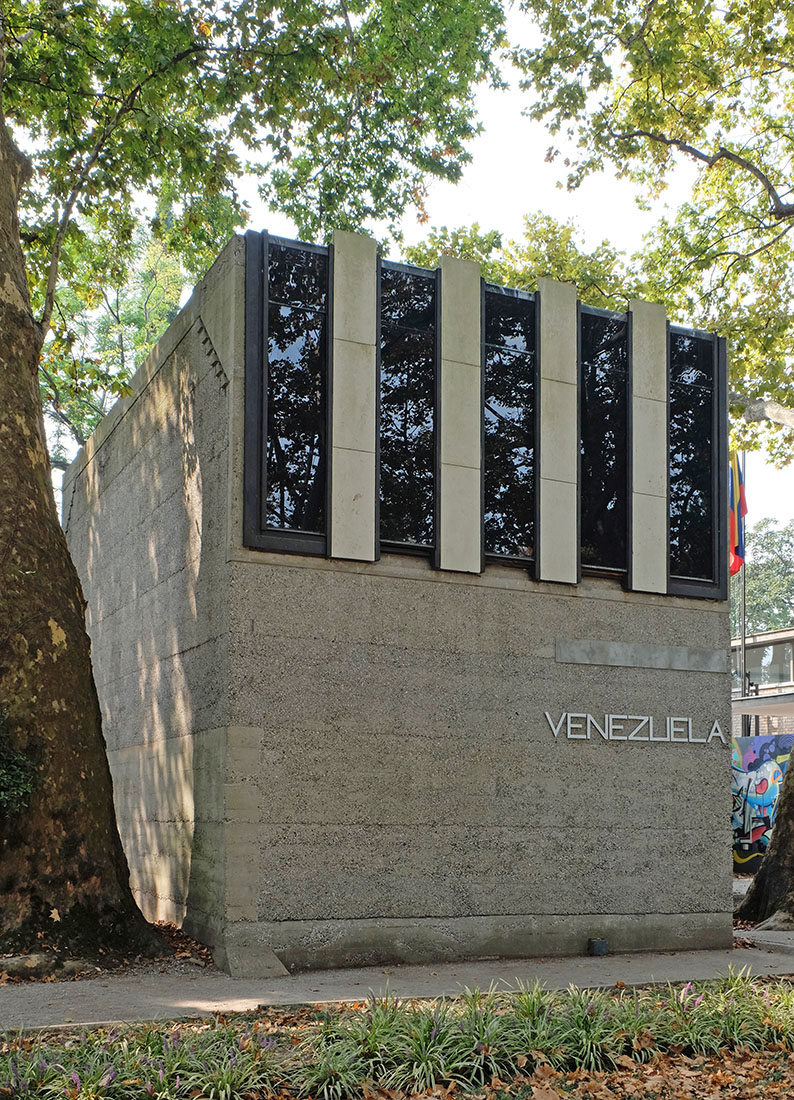 |
 |
 |
 |


Venezuelan Pavilion
Giardini della Biennale, Venice
1954 - 1956
The Venezuelan Pavilion, located in the Castello Gardens of the Venice Biennale, designed by Carlo Scarpa features certain elements which are considered to be typical for his approach, such as the paired structural elements and the layout of the windows. Both motifs reappear in the designs for the Possagno plaster cast gallery, the La Spezia cultural centre, the Carlo Felice Theater in Genova and the Museum in Messina. Carlo Scarpa elaborated three preliminary projects prior the realized design. The Venezuelan Pavilion is to be found between the Swiss Pavilion and the Soviet building, set on a site measuring 300 square metres and featuring mature trees. Appearing as a simple and clear cut building, two rectangular volumes are arranged in a straggered relationship to articulate a tripartite composition. From the exterior a pathway leads to the first exhibition room, which is an intermediate space between interior and exterior. This exhibition space features paired columns supporting a roof made of reinforced concrete. Access to the interiors of the two mentioned rectangles is provided through glazed revolving doors and a revolving panel. On the exterior the volumes are of unfaced concrete, with areas made of glass and marble. The inside of the Venezuelan Pavilion, featuring marble clad walls, is lit by long vertical slit windows rising up to the ceiling. The floor was paved in concrete with wash-gravel, while the ceiling was made of wood and steel. Unhappily, the building was altered in 1968, so that the original spatial sequence is permanently compromised.
Der venezolanische Pavillon, entworfen von Carlo Scarpa, befindet sich in den Schlossgärten der Biennale in Venedig und zeigt bestimmte architektonische Elemente, die als typisch für seinen Angehensweise gelten. So zum Beispiel die paarweise angeordneten Strukturelemente und die Anordnung der Fenster. Beide Motive erscheinen wiederum in den Entwürfen für die Possagno Gipsabdruck Galerie, das Kulturzentrum La Spezia, dem Theater Carlo Felice in Genua und dem Museum in Messina. Carlo Scarpa erarbeitete drei Vorprojekte vor dem realisierten Entwurf. Der venezolanische Pavillon befindet sich zwischen dem Schweizer Pavillon und dem sowjetischen Gebäude, auf einem Areal mit alten Bäumen von 300 Quadratmetern Grösse. Der Pavillon tritt als einfaches und klar geschnittenes Gebäude in Erscheinung. Die zwei rechteckige Volumina sind zueinander in einer versetzten Beziehung angeordnet, so dass eine dreigliedrige Komposition artikuliert wird. Von aussen führt ein Weg zum ersten Ausstellungsraum, welcher als Zwischenraum zwischen Innen und Außen funktioniert. Diese Ausstellungsfläche weist paarweise angeordnete Stützen auf, welche ein Dach aus Stahlbeton tragen. Der Zugang zu den Innenräumen der beiden erwähnten Rechtecken erfolgt durch verglaste Drehtüren und ein drehbares Panel. An der Aussenseite sind die Baukörper aus Sichtbeton mit Bereichen aus Glas und Marmor. Das Innere des venezolanischen Pavillons zeigt mit Marmor verkleideten Wänden. Durch lange vertikale Schlitzfenster die bis zur Decke aufsteigen wird der Innenraum mit natürlichem Licht versorgt. Der Boden war ursprünglich in Beton mit Waschkies gepflastert, während die Decke aus Holz und Stahl bestand. Unglücklicherweise wurde das Gebäude im Jahr 1968 verändert, so dass die ursprüngliche räumliche Abfolge dauerhaft beeinträchtigt ist.